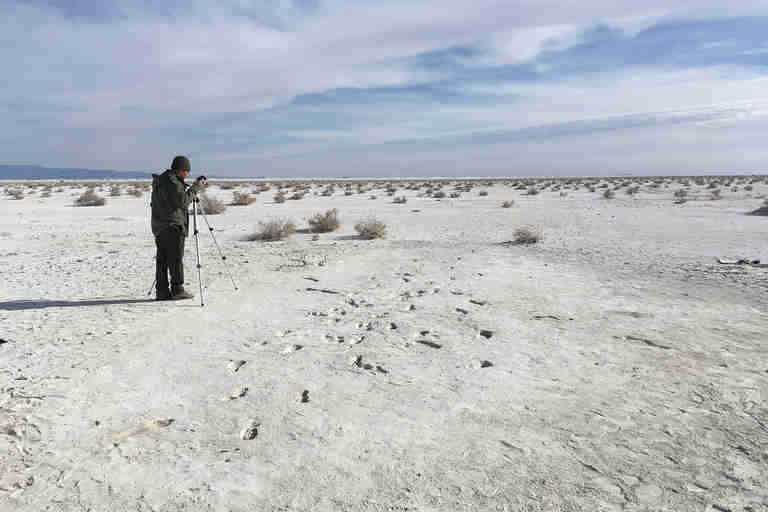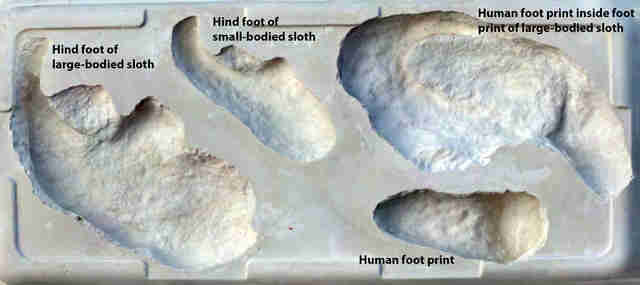 |
| Human footprint inside a sloth track. This composite track is part of a trackway in which the human appears to have stalked the sloth |
Prehistoric footprints for both humans and giant ground sloths have just been discovered at White Sands National Monument in New Mexico. The trackways are interpreted as being the first-known footprint evidence for people hunting. The footprints, described in the journal Science Advances, suggest people 11,000 years ago stalked a giant ground sloth, which was a strong and sharp-clawed animals that could grow up to about 9 feet long.
"Sloth anatomy is not built for speed, but strength," co-author Sally Reynolds of Bournemouth University's Institute for Studies in Landscapes and Human Evolution told Seeker.
"The sloth would have raised itself up to full height and attempted to keep the attackers at bay with its long forearms and large sharp claws," she added. "The hunters would have needed to wait patiently to get the right opportunity to strike the killing blow in a vulnerable part of the sloth anatomy, such as the heart, underbelly, neck, or eyes. The hunters would have been at significant physical risk to themselves while the animal was defending itself."
 |
| General view of Alkali Flat at White Sands National Monument (New Mexico) showing a series of excavated footprints in the foreground |
He explained that peat and sediment were probably reactivated by water, promoting creation of the now-preserved tracks.
He said footprints from multiple people of various ages were discovered along the edge of the lake bed, which is now a playa. A small number of the prehistoric individuals went out into the drying lake bed. The tracks that they left behind show that they were barefoot, but today would have fit into men's shoes sized at about 8.5 in US size, 8 in UK.
The humans appear to have been following, and sometimes even stepping into, prints left behind by about 2–3 giant ground sloths. In the absence of human tracks, these animals tend to travel in a straight or curvilinear fashion. Here, the lumbering beasts distantly related to anteaters and armadillos made sharp changes in their direction of travel. These changes correspond to the approaching humans.
In one track, a line of human toe impressions suggests that the person approached a giant ground sloth on tiptoe while at least one other person was behind the animal.
These, and the other footprints, according the authors suggest a group of people gathered along the edge of the drying lakebed, possibly to keep the sloths out on the flat mud where they could more easily be attacked.
"One hunter stalks the sloth, harassing it so that it turns toward the stalker," Bennett said. "It rises on its hind legs and swings its forelegs around, putting its claws down to steady itself as it swings."
"While the sloth is distracted," he continued, "another hunter approached and tried to land the killing blow. If successful, the sloth would then have been killed or followed as it bled to death. Having the rest of the group as distant observers would mean that others would be on hand to deal with the carcass, if required."
 |
| Composite cast showing a range of footprints from the White Sands National Monument field site |
If the humans were, as suspected, members of the Clovis culture from the American Southwest, they likely would have been hunting the giant sloths with long spears in hand. The researchers are not sure what specific species of giant sloth met its doom at the site, now called Alkali Flat, but Nothrotheriops and Paramylodon both lived in what is now New Mexico during the late Pleistocene.
Notably, all four species of giant ground sloths went extinct shortly afterward — approximately 10,000 years ago.
"This helps us to clarify the debate about how human hunting may have impacted these megafaunal extinctions," Reynolds said.
Read more at Seeker
No comments:
Post a Comment